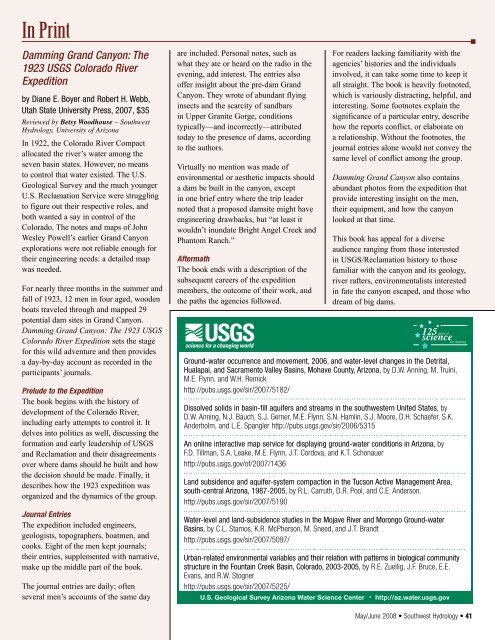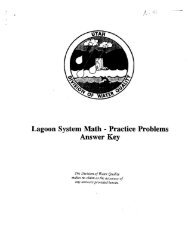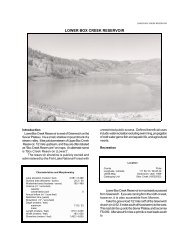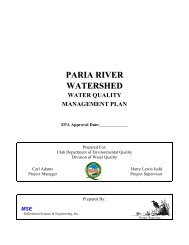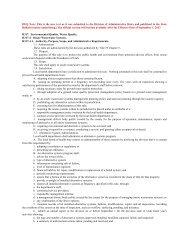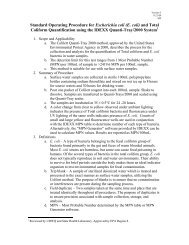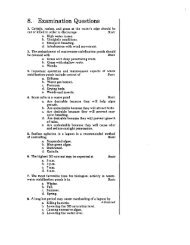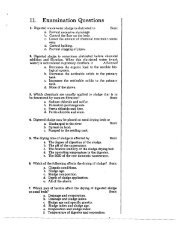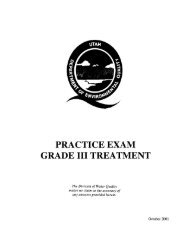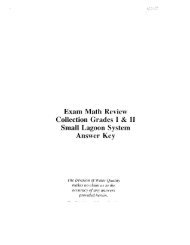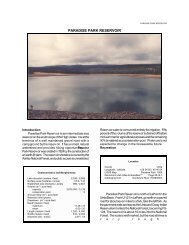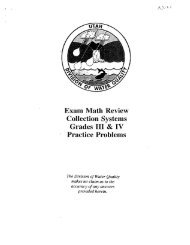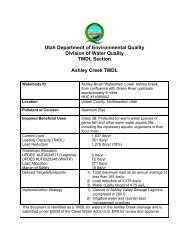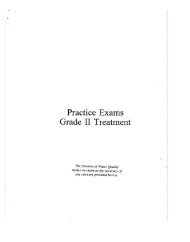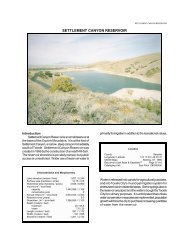Aquifer Recharge, Storage, and Recovery - Southwest Hydrology ...
Aquifer Recharge, Storage, and Recovery - Southwest Hydrology ...
Aquifer Recharge, Storage, and Recovery - Southwest Hydrology ...
- No tags were found...
You also want an ePaper? Increase the reach of your titles
YUMPU automatically turns print PDFs into web optimized ePapers that Google loves.
In PrintDamming Gr<strong>and</strong> Canyon: The1923 USGS Colorado RiverExpeditionby Diane E. Boyer <strong>and</strong> Robert H. Webb,Utah State University Press, 2007, $35Reviewed by Betsy Woodhouse – <strong>Southwest</strong><strong>Hydrology</strong>, University of ArizonaIn 1922, the Colorado River Compactallocated the river’s water among theseven basin states. However, no meansto control that water existed. The U.S.Geological Survey <strong>and</strong> the much youngerU.S. Reclamation Service were strugglingto figure out their respective roles, <strong>and</strong>both wanted a say in control of theColorado. The notes <strong>and</strong> maps of JohnWesley Powell’s earlier Gr<strong>and</strong> Canyonexplorations were not reliable enough fortheir engineering needs: a detailed mapwas needed.For nearly three months in the summer <strong>and</strong>fall of 1923, 12 men in four aged, woodenboats traveled through <strong>and</strong> mapped 29potential dam sites in Gr<strong>and</strong> Canyon.Damming Gr<strong>and</strong> Canyon: The 1923 USGSColorado River Expedition sets the stagefor this wild adventure <strong>and</strong> then providesa day-by-day account as recorded in theparticipants’ journals.Prelude to the ExpeditionThe book begins with the history ofdevelopment of the Colorado River,including early attempts to control it. Itdelves into politics as well, discussing theformation <strong>and</strong> early leadership of USGS<strong>and</strong> Reclamation <strong>and</strong> their disagreementsover where dams should be built <strong>and</strong> howthe decision should be made. Finally, itdescribes how the 1923 expedition wasorganized <strong>and</strong> the dynamics of the group.Journal EntriesThe expedition included engineers,geologists, topographers, boatmen, <strong>and</strong>cooks. Eight of the men kept journals;their entries, supplemented with narrative,make up the middle part of the book.The journal entries are daily; oftenseveral men’s accounts of the same dayare included. Personal notes, such aswhat they ate or heard on the radio in theevening, add interest. The entries alsooffer insight about the pre-dam Gr<strong>and</strong>Canyon. They wrote of abundant flyinginsects <strong>and</strong> the scarcity of s<strong>and</strong>barsin Upper Granite Gorge, conditionstypically—<strong>and</strong> incorrectly—attributedtoday to the presence of dams, accordingto the authors.Virtually no mention was made ofenvironmental or aesthetic impacts shoulda dam be built in the canyon, exceptin one brief entry where the trip leadernoted that a proposed damsite might haveengineering drawbacks, but “at least itwouldn’t inundate Bright Angel Creek <strong>and</strong>Phantom Ranch.”AftermathThe book ends with a description of thesubsequent careers of the expeditionmembers, the outcome of their work, <strong>and</strong>the paths the agencies followed.For readers lacking familiarity with theagencies’ histories <strong>and</strong> the individualsinvolved, it can take some time to keep itall straight. The book is heavily footnoted,which is variously distracting, helpful, <strong>and</strong>interesting. Some footnotes explain thesignificance of a particular entry, describehow the reports conflict, or elaborate ona relationship. Without the footnotes, thejournal entries alone would not convey thesame level of conflict among the group.Damming Gr<strong>and</strong> Canyon also containsabundant photos from the expedition thatprovide interesting insight on the men,their equipment, <strong>and</strong> how the canyonlooked at that time.This book has appeal for a diverseaudience ranging from those interestedin USGS/Reclamation history to thosefamiliar with the canyon <strong>and</strong> its geology,river rafters, environmentalists interestedin fate the canyon escaped, <strong>and</strong> those whodream of big dams.Ground-water occurrence <strong>and</strong> movement, 2006, <strong>and</strong> water-level changes in the Detrital,Hualapai, <strong>and</strong> Sacramento Valley Basins, Mohave County, Arizona, by D.W. Anning, M. Truini,M.E. Flynn, <strong>and</strong> W.H. Remickhttp://pubs.usgs.gov/sir/2007/5182/Dissolved solids in basin-fill aquifers <strong>and</strong> streams in the southwestern United States, byD.W. Anning, N.J. Bauch, S.J. Gerner, M.E. Flynn, S.N. Hamlin, S.J. Moore, D.H. Schaefer, S.K.Anderholm, <strong>and</strong> L.E. Spangler http://pubs.usgs.gov/sir/2006/5315An online interactive map service for displaying ground-water conditions in Arizona, byF.D. Tillman, S.A. Leake, M.E. Flynn, J.T. Cordova, <strong>and</strong> K.T. Schonauerhttp://pubs.usgs.gov/of/2007/1436L<strong>and</strong> subsidence <strong>and</strong> aquifer-system compaction in the Tucson Active Management Area,south-central Arizona, 1987-2005, by R.L. Carruth, D.R. Pool, <strong>and</strong> C.E. Anderson.http://pubs.usgs.gov/sir/2007/5190Water-level <strong>and</strong> l<strong>and</strong>-subsidence studies in the Mojave River <strong>and</strong> Morongo Ground-waterBasins, by C.L. Stamos, K.R. McPherson, M. Sneed, <strong>and</strong> J.T. Br<strong>and</strong>thttp://pubs.usgs.gov/sir/2007/5097/Urban-related environmental variables <strong>and</strong> their relation with patterns in biological communitystructure in the Fountain Creek Basin, Colorado, 2003-2005, by R.E. Zuellig, J.F. Bruce, E.E.Evans, <strong>and</strong> R.W. Stognerhttp://pubs.usgs.gov/sir/2007/5225/May/June 2008 • <strong>Southwest</strong> <strong>Hydrology</strong> • 41


